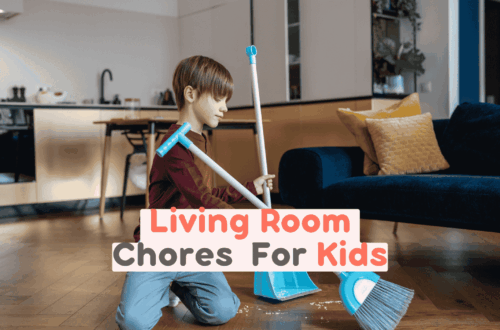You call their name, you remind, you bribe, and still the socks stay on the bedroom floor. If you’ve labeled your child “lazy” in the heat of a messy morning, you’re not alone. Many parents struggle to turn passive or unmotivated kids into helpful members of the household without turning every chore into a power struggle. The good news: lazy behavior is often a sign of unclear expectations, low motivation, or missed opportunities to build skills, not a permanent character flaw.
Below you’ll find practical, evidence-informed strategies for how to encourage lazy kids to help out, step-by-step actions that teach responsibility, build independence, and reduce nagging. For hands-on help, start with a free printable chore chart tailored by age to set clear expectations and track progress: Download printable chore charts by age.
Why it matters
Getting kids involved in household tasks does more than keep your home tidy. Regular chores teach life skills, boost self-efficacy, and help children feel they contribute to the family. Research on motivation offers insight: self-determination theory shows that supporting kids’ autonomy, competence, and relatedness increases intrinsic motivation (Deci & Ryan, 2000). Deci & Ryan explain why giving kids choice and competence-building tasks matters.
Bandura’s work on self-efficacy also applies: children who experience success with small chores gain confidence and are more likely to try harder tasks over time (Bandura, 1977). Bandura (1977) shows how mastery experiences shape future effort.
How to Encourage Lazy Kids to Help Out: 12 Practical Tips
Here’s a scannable list of clear, practical strategies, each one focused on changing the environment, expectations, or the way you ask, so kids move from reluctance to routine.
1. Set tiny first steps
Start with micro-tasks: put toys in a bin, place shoes on a rack, clear one plate. Small wins build momentum and competence.
2. Use a visible chore chart
Kids respond to structure. A simple chart (visual for younger kids) makes expectations clear and reduces “I forgot” excuses. Get age-appropriate worksheets to match chores to abilities: download printable chore charts.
3. Offer choice, not orders
“Do you want to feed the dog or set the table?” gives a sense of control, which increases cooperation.
4. Pair tasks with play or music
Turn sock-sorting into a race, or play a clean-up playlist. Fun reframes the task from punitive to playful.
5. Teach – don’t assume
Show how to do chores step-by-step. Role model the skill, then practice together until they can do it independently.
6. Schedule regular chore times
Consistency builds habit. Short, predictable routines (10–15 minutes after dinner) make chores an automatic part of the day.
7. Use age-appropriate expectations
Match the task to the child’s developmental level so they can succeed, see the chores by age guide for suggestions.
8. Make the payoff meaningful
Link chores to privileges they care about (screen time, playdate) or to family pride: “When everyone helps, we all enjoy a nicer home.”
9. Praise effort, not perfection
Highlight progress: “You cleared your plates without being asked, that helps the whole family.” Avoid vague praise and focus on specific behaviors.
10. Set natural consequences
When a chore is skipped, let the natural result follow (missing a clean shirt for school, or no dessert if they didn’t help with dinner cleanup). Keep consequences reasonable and related to the task.
11. Use a team approach
Make chores family-time: work side-by-side for five minutes. Kids often follow when they see parents doing the same.
12. Track progress and celebrate milestones
Visual tracking (stickers, checkmarks) and small celebrations for streaks turn chores into an achievable game. If you want printable trackers that change as kids grow, try these charts: printable chore charts by age.
Common mistakes to avoid (and quick fixes)
- Lecturing instead of guiding: Keep directions short and specific. Show, then let them try.
- Using only punishment: Balance limits with opportunities for competence and choice.
- Mismatched expectations: Don’t expect a 6-year-old to fold fitted sheets. Use age-appropriate tasks.
- All or nothing thinking: If they do one small part, acknowledge it, progress beats perfection.
Tracking chores and staying consistent, use tools that help
Consistency is the secret sauce. Digital tools and apps remove friction, reduce reminders, and make tracking rewarding for kids. Kikaroo’s chore tracker helps parents assign tasks, set rewards, and visualize progress so chores don’t end up as daily arguments. Try the app to automate reminders and let kids earn points for completed tasks: Get Kikaroo.
Internal links and further reading
For more detail on matching chores to development, see our ultimate chores by age guide. If you’re trying to reduce nagging and power struggles, check these practical tips to make chores easier. To learn strategies for long-term motivation, read our post on how to motivate kids. For tools and printables that pair well with the strategies above, see our guide to chore chart tools and apps.
FAQ snippet
Q: What if my child refuses every chore?
A: Start with tiny, clearly defined tasks and offer a choice between two acceptable options. Avoid shouting, instead, set a short timer and work alongside them to model how to begin.
Q: Are rewards okay?
A: Yes, when used thoughtfully. Small, immediate rewards for new or unpleasant tasks can jump-start behavior. Gradually shift to intrinsic rewards (pride, competence) as the habit forms. Use tools like chore charts to phase out external rewards over time.
Q: How long before chores become routine?
A: Habits can form in a few weeks of consistent practice. Expect progress rather than perfection; reinforce small wins and keep expectations age-appropriate.
Conclusion
Helping a child move from lazy to launched is less about fixing them and more about changing the environment: clear expectations, small successes, and the right incentives build responsibility and kids’ independence. Use a simple chore chart, match tasks to ability, and support competence with brief coaching, and you’ll likely see a steady shift. Ready to stop nagging and start tracking? Try Kikaroo to assign tasks, automate reminders, and celebrate progress: Try Kikaroo.

 Home
Home Features
Features Testimonials
Testimonials Downloads
Downloads FAQ
FAQ Blog
Blog








